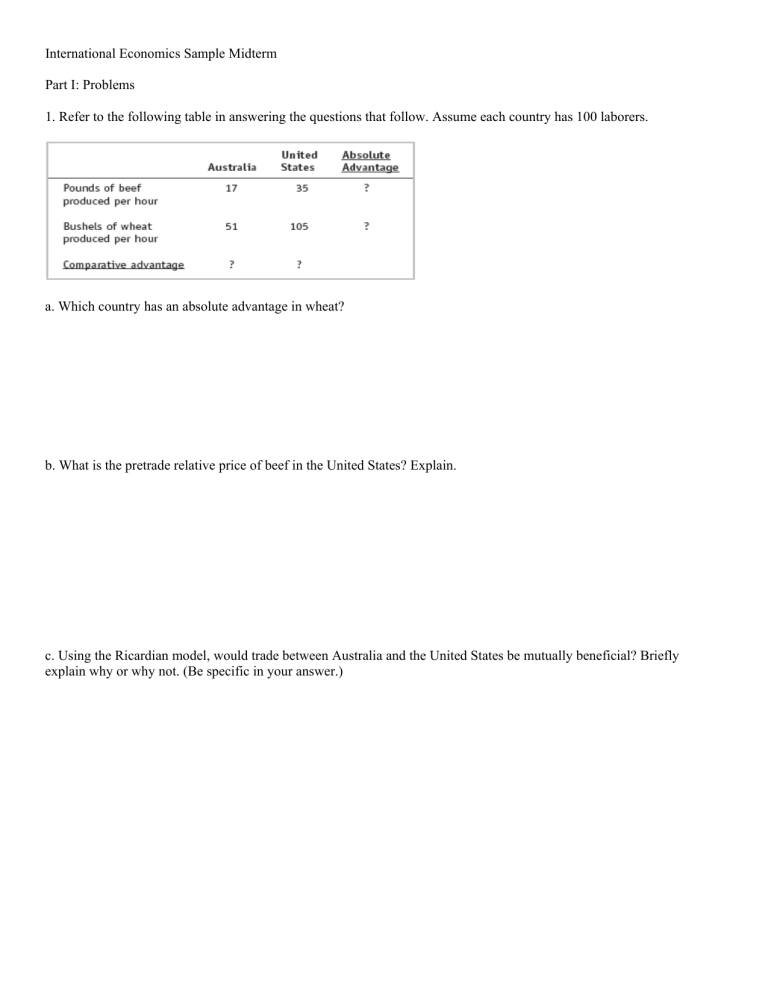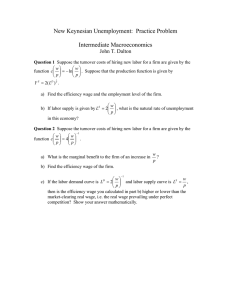
International Economics Sample Midterm Part I: Problems 1. Refer to the following table in answering the questions that follow. Assume each country has 100 laborers. a. Which country has an absolute advantage in wheat? b. What is the pretrade relative price of beef in the United States? Explain. c. Using the Ricardian model, would trade between Australia and the United States be mutually beneficial? Briefly explain why or why not. (Be specific in your answer.) 2. Use the following information to answer the questions below: Computers: Total revenue = 120 Payments to labor = 60 Payments to capital = 60 Soybeans: Total revenue = 120 Payments to labor = 80 Payments to land = 40 Holding the price of computers constant, suppose the price of soybeans rises 10% and that the wage rate increases 5%. a. What is the effect of these changes on the rental rate of capital? b. What is the effect of these changes on the rental rate of land? c. What is the impact on the welfare of labor? 3. Suppose two countries, Greece and Australia, produce wine and wheat using labor and capital as factors of production. Suppose Greece is capital abundant and wheat production is labor-intensive. For each of the following, indicate whether there is an increase, decrease, no change, or unable to determine as the two countries shift from no-trade to free trade. Greece Australia Relative rice of wine Quantity of wine production Quantity of wheat production Quantity of wine exported Quantity of wheat exported 4. Suppose two countries, France and Germany, use only capital and labor for production. France has 2,050 units of capital and 916 units of labor and Germany has 816 units of capital and 270 units of labor. Both countries produce two goods, cars and wine. In Germany, there are 366 units of capital and 135 units of labor employed in the wine industry. In France, there are 926 units of capital and 618 units of labor employed in the wine industry. a. Which industry is labor-intensive in Germany? Which industry is capital-intensive in Germany? b. Now, suppose the two countries trade with one another. What will happen to the relative price of wine in France? In Germany? c. What are the effects of free trade on wage and rental on capital in Germany? 5. Using an appropriate graph, show the short-run effects of immigration on the receiving country. Fully label the graph and explain. 6. Assume that Mexico receives an inflow of FDI. Suppose two factors (labor and capital) are used in the production in two industries (food and televisions). Further assume that televisions are capital intensive as compared with food. Use the long-run specific-factors model to answer the following questions. a. Show the impact of the inflow of FDI on Mexico in an illustration with output of food (televisions) on the vertical (horizontal) axis. What happens to the output of each good? b. How has the wage changed in terms of food and televisions? Part II: Short Answer 1. Home, a small, open economy, uses a mobile factor (labor) and two specific factors (drylands and wetlands) to produce two goods, cactus and rice. Dryland is only productive in growing cactus and wetlands can only grow rice. Suppose the world relative price of cactus is higher than Home. Determine the effect of this price increase on the real wage and real returns on the different types of land. 2. How do economies of scale lead to gains from trade under monopolistic competition? 3. What are the main differences between the outsourcing phenomena in manufacturing versus services? Part III: Definitions 1. Export supply curve: 2. Real wage: 3. Stolper Samuelson theorem: 4. Factor price insensitivity: 5. Dumping: Answers: Part I: 1a. The United States has an absolute advantage in the production of wheat because it can produce 105 pounds of wheat per hour whereas Australia can produce 51 pounds in the same hour. b. The pretrade relative price of beef in the US is 105/35 =3 bushels of wheat. We derive this result from the fact wages must be equal across industries, so that MPLBeef*PBeef = MPLWheat*PWheat Æ PBeef / PWheat = MPLWheat/MPLBeef c. Australia and the United States will not engage in trade because there are no differences in opportunity costs between the two countries, so there are no opportunities to gain from trade according to the Ricardian model. We can also see this by comparing the relative price of beef, which is 3 bushels of wheat in both countries. 2a. dRK/RK = [(dPc/Pc)(QcPc) –(dW/W)(WLc)]/RKK = -5%(60/60) = -5% b. dRT/RT = [(dPs/Ps)(QsPs) –(dW/W)(WLs)]/RTT = (10%*120 – 5%*80)/40 = +10% c. The effect is ambiguous. The nominal wage increased by 5%, but the real wage has fallen in terms of soybeans but risen in terms of computers. 3. 4a. In Germany, the car industry is capital- intensive and the wine industry is labor intensive b. With free trade, the relative price of wine will increase in France and decrease in Germany. c. the decrease in the relative price of wine would lead to a decrease in wage and a rise in the rental on capital. 5. 6a. Due to the inflow of FDI, more labor and more capital are in televisions so that the output of that industry goes up. By contrast, less labor and less capital are devoted to the production of food, leading to a fall in the output in this industry. As predicted by the Rybczynski theorem, the additional capital increased the output of the capital-intensive industry (televisions) and decreased the output of the labor-intensive industry (food). 6b. Because the capital-intensive industry (televisions) absorbed the additional capital along with the shift of labor from the labor intensive industry, the capital/labor ratios remained constant. With the capital/labor ratios unchanged across the two industries, the wage is also unchanged. With constant factor prices, wage does not change in terms of either food or televisions. Part II: 1. Because the world-relative price of cactus is higher than Home, the small country will export cactus, which will lead to an increase in the real rental on drylands. Real wage will increase in terms of rice because of the increase in the price of cactus but will fall in terms of cactus because the percentage rise in the price of cactus is higher than the percentage increase in wage. 2. Through trade, firms are able to expand their outputs by selling in the Foreign market. With the rise in the number of product varieties available, competition increases in the importing country, which drives prices to fall. Although some firms exit the market because of the losses resulting from the lower prices, the remaining firms are able to reduce their average costs through economies of scale by expanding their output. Consumers in the importing country gain from the lower prices charged by firms as a result of the decrease in average costs. Consumers also benefit from the increase in the product varieties. 3. Manufacturing involves unskilled intensive labor such as the assembly of goods. Therefore, outsourcing in manufacturing entails the movement of unskilled-intensive activities overseas and occurs in countries with low-wage unskilled labor. By contrast, services outsourcing, particularly of business services such as accounting, auditing, human resources, order processing, telemarketing, and after-sales service for computer purchases uses skilled-intensive labor. Although outsourcing in services also take place in low-wage countries, these activities are performed by skilled labor. As such, India is a favored destination for service outsourcing because the wages of educated workers are lower relative to those in the United States. Moreover, manufacturing outsourcing of intermediate inputs may be traded across borders several times. Due to the slicing of production process, each country involved must have reliable infrastructures, such as efficient road and transport networks. Part III: 1. Export supply curve: shows the relationship between the world price for a good and the quantity a country will export. 2. Real wage: the wage stated in purchasing power of different goods; wage divided by price of the good. 3. Stolper Samuelson theorem: when all factors are mobile, an increase in the relative price of a good will lead to an increase in the real earnings of the factor used intensively in that sector and a decrease in real earnings for the other factor. 4. Factor price insensitivity: a feature of the HO model; an increase in the quantity of a factor does not need to result in a change in factor prices. 5. Dumping: is claimed when firms charge a lower price for their products in foreign relative to domestic markets.



